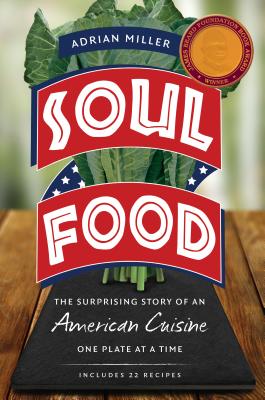Book Review: Soul Food: The Surprising Story Of An American Cuisine, One Plate At A Time
by Adrian Miller
List Price: $22.00The University of North Carolina Press (Feb 01, 2017)
Nonfiction, Paperback, 256 pages
More Info ▶
Book Reviewed by Kam Williams
From frontier cabins to plantation houses to the White House, from steamboat galleys and Pullman kitchens to public barbecues and fish fries and private homes without number, black chefs and cooks and servants have elevated the art of American cookery and distinguished themselves in the process, and they and all other Americans need to see the story fully told…
This is the story of soul food. Down through history, African-American cuisine has gone by several names since enslaved West Africans arrived in British North America: slave food, the master’s leftovers, southern food, country cooking, home cooking, down home cooking…
Of them, southern food and soul food are the labels most used, but they also tend to confuse. This book explores where southern food ends and soul food begins, and why soul food became the most recognized aspect of African-American cooking.”
—Excerpted from the Preface (pages xiii-xiv)
In recent years, soul food has gotten a bad rap, basically because many folks have come to think of it as unhealthy. Some have even gone so far as to indict it as the leading cause of chronic diseases and early death among African-American men over 40.
But Adrian Miller would be more inclined to blame it on a shift in the black diet’s away from traditional cuisine in favor of processed and fast food. Miller, a certified barbecue judge from Denver, Colorado, does concede, however, that soul food dishes were originally higher in sugar and fat than their southern food counterparts, since these ingredients were needed to spice up what were the master’s leftovers which were generally starchier, blander and bonier.
In this highly-informative opus, the author not only relates the history of soul food in intimate fashion, one plate at a time, but he includes 22 recipes for such scrumptious staples as Macaroni and Cheese, Catfish Curry, Deep-Fried Chitlins, Fried Chicken, Cornbread, Candied Yams, Black-Eyed Peas, Banana Pudding and Peach Crisp.
The book is filled with fascinating factoids. For instance, in a chapter entitled, “Chitlins: A Love Story,” we learn that pig intestines were once a delicacy appreciated as much by masters as by slaves. When Confederate General Joseph Wheeler’s cavalry stopped at a plantation in search of sustenance, his men devoured the chitlins offered so quickly that he didn’t get a bite.
A chapter playfully called, “Sometimes I feel Like Motherless Greens,” discusses the differences among the dozen of leafy plants regularly found on the dinner tables of down home chefs, such as cabbage, collards, kale, watercress, lettuce, dandelion, and turnip and beet greens, to name a few.
By book’s end, it is obvious that the author is concerned that his favorite culinary fare might soon become extinct. Thus, it’s no surprise when he chooses to close his heartfelt homage with the impassioned conviction that despite the changing times, “Soul food can keep its flavor without losing its soul.”
Johnetta’s Mixed Greens

Reciepe from the book Copyright © 2013 by Adrian Miller. Used by permission
of the University of North Carolina Press (www.uncpress.unc.edu).
This is my favorite thing to make in the soul food genre. I didn’t grow up eating collards. My mother usually made a combination of mustard and turnip greens. Turnip greens seemed to be the popular option for greens as I traveled through Tennessee. I love the peppery aroma that mustard greens give off while they’re cooking. I’ve lately been using smoked turkey parts to season my greens because they give good flavor with less fat. Yet, every once in a while, I go retro and put on a pot of greens with some ham hocks.
Makes 8 servings
- 2 smoked ham hocks or smoked turkey wings, or 1 leg (1 pound)
- 1 1/2 pounds turnip greens
- 1 1/2 pounds mustard greens
- 1 tablespoon granulated garlic or 2 minced garlic cloves
- 1 medium onion, chopped
- Pinch of crushed red pepper flakes
- Pinch of baking soda
- Pinch of sugar
- Pinch of salt
- Rinse the hocks, wings, or leg, place them in a large pot, and cover with water. Bring to a boil and cook until the meat is tender and the cooking liquid is flavorful, 20 to 30 minutes. Discard the hocks, wings, or leg.
- Meanwhile, remove and discard the tough stems from the greens. Cut or tear the leaves into large, bite-sized pieces. Fill a clean sink or very large bowl with cold water. Add the leaves and gently swish them in the water to remove any dirt or grit. Lift the leaves out of the water and add them to the hot stock, stirring gently until they wilt and are submerged.
- Stir in the onion, pepper flakes, baking soda, sugar, and salt.
- Simmer until the greens are tender, about 30 minutes. Check the seasoning and serve hot.

